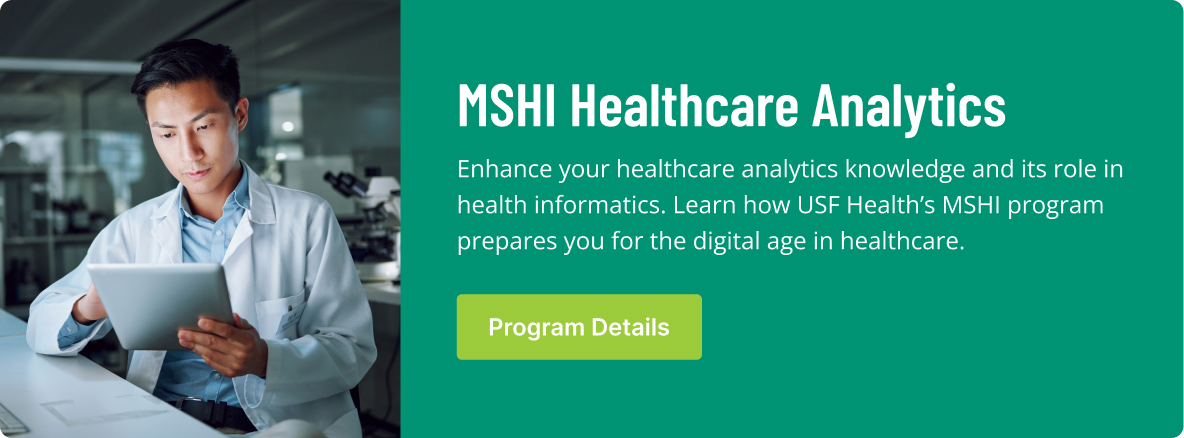The use of innovative technology in healthcare can leave those pursuing a career in the health IT field awash in terms and acronyms that often seem confusing. Among those are the terms healthcare analytics and clinical decision support systems (CDSS).
The two are intertwined, but it’s important to understand how they are different and how they work together.
Healthcare analytics involves the use of data and systematic analysis to improve the quality of healthcare, reduce costs for patients and lead to better patient outcomes. It is often confused with health informatics, which focuses on the management of data in a healthcare system.
Clinical Decision Support Systems are a key component of health IT. Using the insights delivered by healthcare analytics, a CDSS can improve the quality, safety, efficiency and effectiveness of health services. The overall goal of the system is to provide medical professionals and patients with accurate, timely information that leads to better patient outcomes.
Here’s a closer look at both areas.
What a Clinical Decision Support System Does
The emergence of CDSS has coincided with an increase in the data available in medical operations, as well as a switch to a value-based care payment system by medical providers that hinges on patient outcomes.
That’s made the use of big data an important part of the field.
A CDSS tool uses patient information and related healthcare data to make recommendations on the best possible next step in a patient’s treatment. Systems also can alert medical providers to patient information they may not have known about and monitor for problems such as potentially harmful medication interactions.
The Office of the National Coordinator for Health IT defines CDSS as a tool that “provides clinicians, staff, patients or other individuals with knowledge and person-specific information, intelligently filtered or presented at appropriate times, to enhance healthcare. Clinical decision support encompasses a variety of tools to enhance decision-making in the clinical workflow.”
In short, a CDSS acts as a support system for doctors, nurses, and other healthcare providers. The goal is to help them make the best possible clinical decision by offering them insights gleaned from enormous amounts of data.
In a report on the potential for CDSS tools published in the Journal of Digital Humanities, European researchers noted that the technology is key to developing a “learning healthcare system cycle” in which healthcare practice and healthcare research “play a synergistic role.”
“In particular, clinical decision support can be strongly enabled by providing fast access to the same set of heterogeneous data available for research purposes,” the report stated.
How Analytics Support CDS
Healthcare analytics provide the insights used in CDSS. In the healthcare field, this involves a large variety of data research that provides information which clinicians can use in delivering the best possible treatment.
Some examples of how healthcare analytics can be used include the following.
- Using patient-specific data to give medical professionals up-to-date information on a patient’s treatment and medication history
- Using diagnostic data coupled with socioeconomic status to find trends in how some diseases disproportionately impact those with lower incomes
- Using data to find trends in chronic diseases and other healthcare issues among certain patient populations based on factors such as age, location, and ethnicity
- Uncovering trends in patient outcomes as they relate to specific treatment plans for specific medical conditions
- Identifying treatment plans that will provide the best patient outcome at the lowest cost
In general, healthcare analytics fall into three categories.
Descriptive analytics use historical data to describe what has happened in the past with similar patients undergoing certain types of treatment. Predictive analytics show what could happen if certain steps are taken, based on what has happened in the past.
Prescriptive analytics take the next step forward, identifying and recommending actions that can produce the best outcome and allow medical professionals to develop optimal clinical pathways for patient care. This area is the key component in CDSS.
The Future of CDSS
The drive to improve these systems has also driven innovation in healthcare analytics and technology. This is especially true in the area of artificial intelligence and machine learning, which are increasingly being used in CDSS tools.
Both allow for faster and more accurate research based on health data, leading to better decision-making and patient outcomes. Such automated systems can quickly gather and analyze data from disparate sources such as electronic healthcare records (EHR), health insurers, and wearable medical devices.
These analytics tools will raise the skill level of clinicians and lead to better diagnostic decision-making and prescription drug support, according to Douglas Brown, president of healthcare technology and services research company Black Book Research.
Brown said automated analytics tools also will integrate CDSS into EHR workflows, clinical goals and priorities, and lead to more trust in the accuracy and reliability of the underlying data.
All this is still in development, but CDS systems are seen by many healthcare professionals as something that will become standard in the future. For those studying to enter the health IT field, it’s an area they may find themselves working in as data plays a larger role in clinical decision-making.




